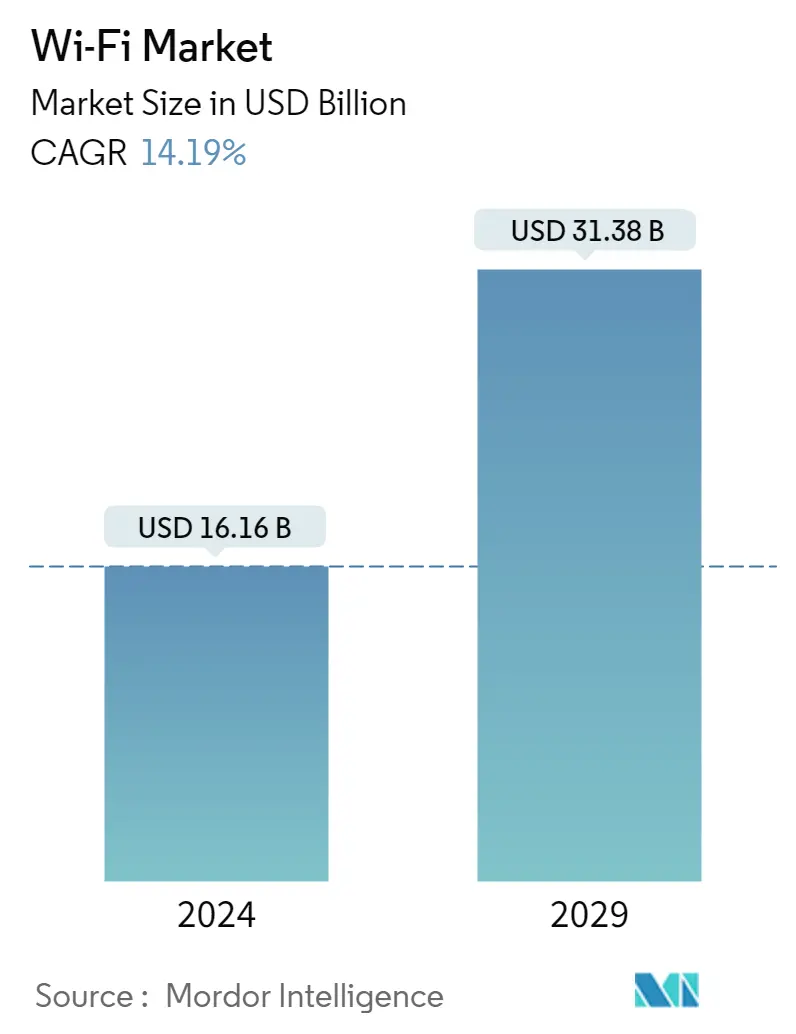Market Size of Wi-Fi Industry

| Study Period | 2021 - 2029 |
| Market Size (2024) | USD 16.16 Billion |
| Market Size (2029) | USD 31.38 Billion |
| CAGR (2024 - 2029) | 14.19 % |
| Fastest Growing Market | Asia-Pacific |
| Largest Market | North America |
Major Players
*Disclaimer: Major Players sorted in no particular order |
Need a report that reflects how COVID-19 has impacted this market and its growth?
WiFi Market Analysis
The Wi-Fi Market size is estimated at USD 16.16 billion in 2024, and is expected to reach USD 31.38 billion by 2029, growing at a CAGR of 14.19% during the forecast period (2024-2029).
Working from home has become a megatrend these days. The speed of the shift to large-scale remote work has resulted in personal devices, including mobile phones, laptops, tablets, desktops, etc.
- Employees are also observed using personal Wi-Fi internet connections to access the corporate network. This unexpected disruption due to the COVID-19 pandemic boosted the use of Wi-Fi to keep businesses and critical functions operational. Moreover, multiple industries globally bounced back from the COVID-19 pandemic by engaging in bandwidth-hungry applications, such as voice, video, and IoT devices. Therefore, as the demand for Wi-Fi increases, wireless networks become oversubscribed, leading the allied IT teams to throttle application performance.
- Machine-to-machine applications are increasingly driven toward wireless connections. Multiple investments in connectivity for retail and manufacturing are contributing to the growth. Such growth creates congestion in the 2.4 and 5 GHz spectrums, driving the demand for the 6 GHz spectrum allocation.
- Further, edge networks and computing have led enterprise architectures to optimize processing for business-critical analysis of data sets from IoT applications and communications. More than 50% of the workloads are performed outside the enterprise data center. This further boosts the requirement for low-latency, real-time communications, and high-definition video applications thanks to the multi-access edge enabled by 5G and Wi-Fi 6.
- For services, the connected networks of control devices are expected to communicate directly with each other without translation or IP-based standards. This integrated approach with wireless connectivity and compute platforms may enable design innovation.
- In the current year, the International Telecommunication Union (ITU) estimates that 5.3 billion people, or 66% of the world's population, will be utilizing the Internet. This represents a 24% increase from 2019, with an estimated 1.1 billion people joining the Internet during that time. With so many more people using the internet, both local and international Wi-Fi router makers will have more chances to come out with new products and boost bandwidth in order to get a big share of the market.
- Additionally, public Wi-Fi networks (those with a pre-shared key) do not represent a safe option. While these networks may have different intentions than retail stores, the absence of a level of assurance or legal obligation for them to secure a device or data poses a threat. Again, users need help to be sure of the intercept and their inability to read and modify their data.
